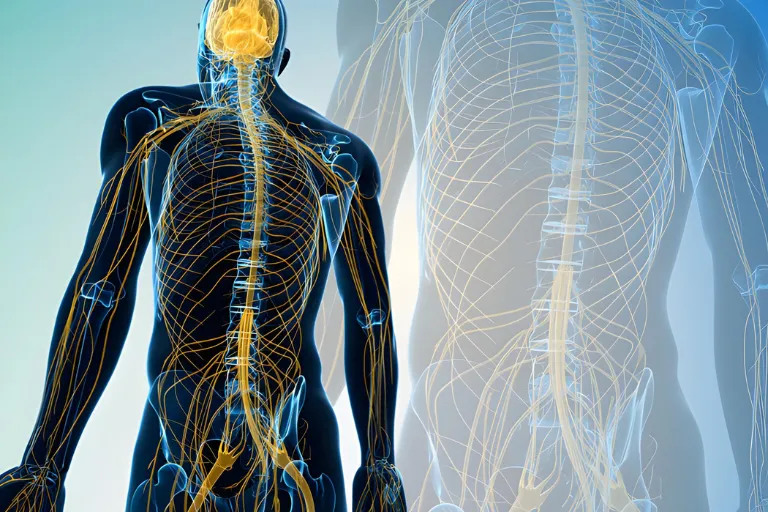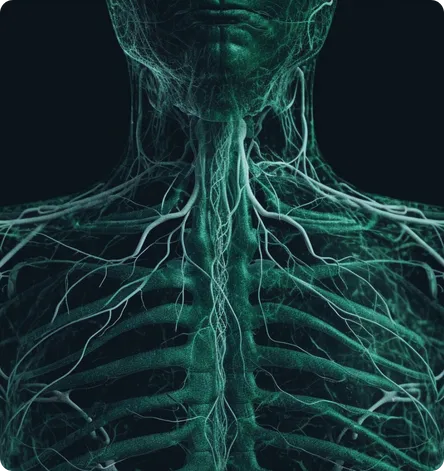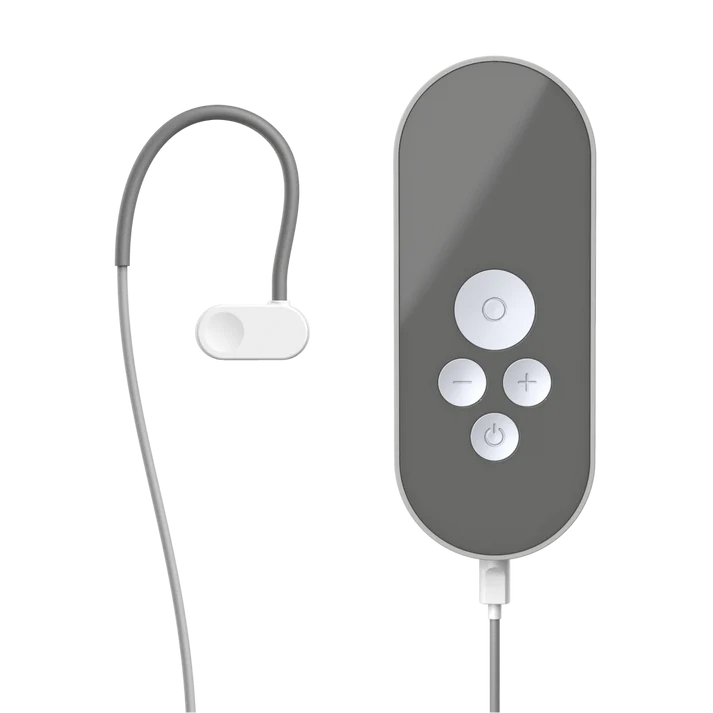Researchers call it the body’s “calm-and-restore” pathway. Here’s why your health depends on it.

Most people know about the heart, the lungs, and the gut.
But very few know about the Vagusnerv — despite the fact that it quietly connects them all.
This single nerve runs from your brainstem, down through your neck, branching out to the heart, lungs, and digestive tract.
It’s the main communication highway between the brain and the body.
And when it’s working well, it helps regulate everything from your heartbeat and breathing to your digestion, inflammation levels, and even your mood.
But when the vagus nerve is underperforming or dysregulated, people can experience a wide range of symptoms that feel disconnected on the surface: poor sleep, digestive troubles, constant fatigue, racing thoughts, or stubbornly low recovery scores on wearables.
It’s not a “life hack.”
It’s one of the most fundamental control systems in the human body.
And science is now showing how supporting it can change the way we feel and function day to day.
What the Vagus Nerve Does — in Plain English

Think of the vagus nerve as the brake pedal for your body’s stress response.
It’s part of the parasympathetic nervous system — the “calm-and-restore” side that balances out the sympathetic “stress-and-alert” side.
When you’re facing a challenge, your stress system activates — your heart rate rises, muscles tense, and your mind sharpens. That’s useful in short bursts.
But after the challenge is over, the vagus nerve is what helps you downshift — lowering your heart rate, calming your breathing, aiding digestion, and steering the body back into recovery.
Without that downshift, your system stays in high idle, quietly draining energy and disrupting basic functions.
Here are some of the areas science has connected to vagus nerve function:
- Stress & Anxiety: A strong vagus response helps the body “switch off” stress chemistry. Weak vagal tone is linked to higher baseline anxiety.
- Sleep Quality: Because it influences heart rate and relaxation, vagal activity is key to entering deep, restorative sleep.
- Digestion: The vagus nerve helps regulate motility and enzyme release in the gut — meaning dysregulation can show up as bloating, cramps, or unpredictable digestion.
- Inflammation: Research shows the vagus nerve triggers an “anti-inflammatory reflex,” calming the immune response. Poor vagal tone is associated with chronic low-grade inflammation.
- Recovery & HRV: Heart rate variability (HRV) is a marker of nervous system flexibility. Higher HRV = strong vagal tone and resilience. Persistently low HRV often reflects vagal underactivity.
In short: this one pathway doesn’t just influence one organ. It coordinates multiple systems at once.
Signs Your Vagus Nerve May Be Out of Balance

Because the vagus nerve touches so many systems, dysregulation can show up in different ways for different people. Common signs include:
- Constant fatigue: You sleep, but wake up groggy and unrefreshed.
- Unrefreshing sleep: Nights are long, but mornings still feel heavy.
- Gut problems: Bloating, cramping, “random” digestive issues.
- Racing thoughts: Hard to switch off at night, even on the sofa.
- Low HRV: Wearables show a flat recovery graph, no matter how healthy your habits.
- Lingering inflammation: “Everything aches” — tight neck, sore back, frequent illness.
- Brain fog: Struggling with focus, memory lapses, feeling like you’re “walking through mud.”
Individually, each symptom might be dismissed. Together, they often trace back to the same overlooked control system.
Everyday Ways to Support the Vagus Nerve

Researchers and clinicians have identified several practices that can gently support vagal activity:
- Breathwork: Slow nasal breathing with longer exhales (for example, inhale 4 seconds, exhale 6 seconds) has been shown to stimulate vagal activity.
- Consistent Sleep Timing: Going to bed and waking up at consistent times helps regulate circadian rhythms and supports vagal balance.
- Meal Pacing: Eating slowly, chewing thoroughly, and avoiding heavy late-night meals reduces digestive stress and engages vagal pathways.
- Cold Exposure: Brief cold showers or splashing the face with cold water can trigger vagal responses in some people.
- Mindfulness & Meditation: Practices that calm the mind often correlate with higher HRV and improved vagal tone.
- Exercise Balance: Alternating hard training with true recovery days helps prevent chronic nervous system strain.
These strategies are helpful and evidence-based — but they also require consistency. And for many people, even after implementing them, the nervous system still struggles to find its balance.
That’s where new technology is making a difference.
A Science-Backed Way to Support Vagal Tone Daily

Over the past two decades, researchers have been exploring Stimulation des Vagusnervs (VNS) as a way to help the nervous system rebalance.
Originally developed for clinical use, VNS has been studied in more than 50 clinical trials across conditions like epilepsy, depression, chronic pain, and anxiety. Results consistently show that when the vagus nerve is gently stimulated, symptoms tied to nervous system imbalance often improve.
Nuropod is a breakthrough in making this approach practical for everyday life.
- It’s a non-invasive, CE-certified, Non-Significant Risk (FDA).
- It uses a small clip placed on the tragus of the ear, where the auricular branch of the vagus nerve is accessible.
- Sessions last 30–60 minutes and can be done while reading, working, or winding down.
- The stimulation is gentle — a light, soothing tingle — and requires no gels or complex setup.
In plain English: it’s like gentle physical therapy for your nervous system.
What Users and Clinicians Report
Nuropod is already used in clinical and home settings across Europe and beyond. Here’s what people typically notice:
- During sessions: a calming effect — “like the volume knob on stress turning down.”
- Over the first weeks: deeper, more restorative sleep; mornings that feel less like hitting a wall.
- With consistency: steadier energy, improved digestion, fewer stress spikes, and HRV profiles that look more flexible.
Doctors recommend it because it’s safe, drug-free, and evidence-backed. Unlike apps that remind you to relax, Nuropod directly engages the control pathway itself — sending a signal the body can’t ignore.
Picture the Difference
Imagine:
- Waking without bargaining with the alarm.
- Drinking coffee because you enjoy it, not because you need it.
- Workdays that feel steady instead of jagged.
- Gut issues that ease instead of surprise you.
- Evenings where your thoughts slow down enough to relax.
- Sleep that actually restores you.
- And, if you track HRV, finally seeing a gentle upward trend in your graph.
That’s not a hack. That’s your nervous system functioning the way it was designed to.

Die Quintessenz
The vagus nerve is not a secret — but it is overlooked.
It’s the body’s natural control pathway for stress, sleep, digestion, inflammation, and recovery.
When it’s underactive, life feels harder than it should.
When it’s supported, daily life becomes smoother, calmer, and more resilient.
You can help your nervous system with simple daily habits — but you can also support it directly.
Nuropod makes that possible.
It’s safe, clinically tested, and designed to integrate into real life.
See how Nuropod helps thousands restore balance to their nervous system.
Every Nuropod Kit is backed by a 30-day, full-refund policy if users aren’t satisfied with their progress.
Der Artikel stellt in keiner Weise eine medizinische Beratung dar. Bitte konsultieren Sie einen zugelassenen Arzt, bevor Sie eine Behandlung beginnen. Diese Website kann Provisionen für die in diesem Artikel erwähnten Links oder Produkte erhalten.


